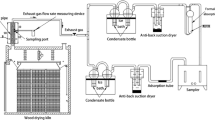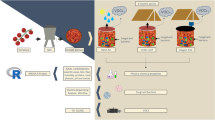Abstract
Main conclusion
New non-destructive approach to evaluate the retting process was investigated. Increase of retting duration led to a decrease of VOCs emitted by plants and change of color and plant odor. The variation of VOCs and odor could be used as indicators for the degree of retting.
Abstract
In the hemp industry, retting is an upstream bioprocessing applied to the plants to facilitate the decortication of fibres from the central woody part of the stem. This treatment is currently carried out in an empirical way on the ground which leads to variability in the hemp stems quality, and thus to the hemp fibres quality. Therefore, controlling retting treatment is a crucial step for high-performance hemp fibre. In this study, a new approach is used to assess the retting degree by following the evolution of VOCs emitted by plants during different retting durations. Either harvest time or retting induces a change in VOCs released by plants. During plant maturity, volatile compounds emitted decreased with a factor of about 2, in relation to VOCs released at the end of flowering. Regardless of the harvest period, the majority of VOCs and odor concentrations, monitored by olfactometric analysis, decrease gradually until some of them disappear at the end of retting. Likewise, the green plant odor disappears during retting with an increase of dry plants odor and an appearance of fermented odor at the end of retting. Following the evolution of VOCs emitted by plants during retting could be a tool for farmers to improve the retting management.







Similar content being viewed by others
References
Akin DE, Condon B, Sohn M et al (2007) Optimization for enzyme-retting of flax with pectate lyase. Ind Crops Prod 25:136–146
Amaral JA, Knowles R (1997) Inhibition of methane consumption in forest soils and pure cultures of methanotrophs by aqueous forest soil extracts. Soil Biol Biochem 29:1713–1720
Aziz SH, Ansell MP (2004) The effect of alkalization and fibre alignment on the mechanical and thermal properties of kenaf and hemp bast fibre composites: part 1—polyester resin matrix. Compos Sci Technol 64:1219–1230
Bleuze L, Lashermes G, Alavoine G, Recous S, Chabbert B (2018) Tracking the dynamics of hemp dew retting under controlled environmental conditions. Ind Crops Prod 123:55–63
Bourmaud A, Baley C (2010) Effects of thermo mechanical processing on the mechanical properties of biocomposite flax fibers evaluated by nanoindentation. Polym Degrad Stab 95:1488–1494
Cabrol L, Malhautier L (2011) Integrating microbial ecology in bioprocess understanding: the case of gas biofiltration. Appl Microbiol Biotechnol 90:837–849
Capitani D, Brilli F, Mannina L et al (2009) In situ investigation of leaf water status by portable unilateral nuclear magnetic resonance. Plant Physiol 149:1638–1647
Cariou S, Chaignaud M, Montreer P et al (2016) Odor concentration prediction by gaschromatography and mass spectrometry (GC–MS): importance of VOCs quantification and odor detection threshold accuracy. Chem Eng Trans 54:67–72
Chaignaud M, Cariou S, Poette J et al (2014) A new method to evaluate odour annoyance potential. Chem Eng Trans 40:13–18
Cookson JT (1995) Bioremediation engineering; design and application. McGraw-Hill, New York
Copolovici L, Niinemets Ü (2010) Flooding induced emissions of volatile signalling compounds in three tree species with differing waterlogging tolerance. Plant Cell Environ 9:1582–1594
Djemiel C, Grec S, Hawkins S (2017) Characterization of bacterial and fungal community dynamics by high-throughput sequencing (HTS) metabarcoding during flax dew-retting. Front Microbiol 8:1–16
Duval A, Bourmaud A, Augier L, Baley C (2011) Influence of the sampling area of the stem on the mechanical properties of hemp fibers. Mater Lett 65:797–800
ElSohly MA, Slade D (2005) Chemical constituents of marijuana: the complex mixture of natural cannabinoids. Life Sci 78:539–548
Fall R, Benson AA (1996) Leaf methanol—the simplest natural product from plants. Trends Plant Sci 1:296–301
Filella I, Peñuelas J (1999) Altitudinal differences in UV absorbance, UV reflectance and related morphological traits of Quercus ilex and Rhododendron ferrugineum in the Mediterranean region. Plant Ecol 145:157–165
Galbally IE, Kirstine W (2002) The production of methanol by flowering plants and the global cycle of methanol. J Atmos Chem 43:195–229
Gershenzon J, Croteau R (1991) Terpenoids. In: Rosenthal G, Berenbaum M (eds) Herbivores : their interactions with secondary plant metabolites. The chemical participants, vol I. Academic Press, USA, pp 165–219
Gfeller A, Laloux M, Barsics F et al (2013) Characterization of volatile organic compounds emitted by barley (Hordeum vulgare L.) roots and their attractiveness to wireworms. J Chem Ecol 39:1129–1139
Ginkel CG, Jong E, Tilanus JWR, Bont JAM (1987) Microbial oxidation of isoprene, a biogenic foliage volatile and of 1,3-butadiene, an anthropogenic gas. FEMS Microbiol Lett 45:275–279
Hartikainen K, Am Nerg, Kivimaenpaa M et al (2009) Emissions of volatile organic compounds and leaf structural characteristics of European aspen (Populus tremula) grown under elevated ozone and temperature. Tree Physiol 29:1163–1173
Hatanaka A (1996) The fresh green odor emitted by plants. Food Rev Int 12:303–350
Henriksson G, Akin DE, Hanlin RT et al (1997) Identification and retting efficiencies of fungi isolated from dew-retted flax in the United States and Europe. Appl Environ Microbiol 63:3950–3956
Högnadóttir Á, Rouseff RL (2003) Identification of aroma active compounds in orange essence oil using gas chromatography-olfactometry and gas chromatography–mass spectrometry. J Chromatogr A 998:201–211
Holopainen JK, Blande JD (2012) Molecular plant volatile communication. Sens Nat 739:17–31
Hörtensteiner S (2004) The loss of green color during chlorophyll degradation—a prerequisite to prevent cell death? Planta 219:191–194
Huang P-Y, Zimmerli L (2014) Enhancing crop innate immunity: new promising trends. Front Plant Sci 5:624
Islam MS, Kim LP, Nic JF (2010) Influence of alkali fiber treatment and fiber processing on the mechanical properties of hemp/epoxy composites Mohammad. J Appl Polym Sci 21:449–456
Joshi SV, Drzal LT, Mohanty AK, Arora S (2004) Are natural fiber composites environmentally superior to glass fiber reinforced composites? Compos Part A Appl Sci Manuf 35(371–376):6
Kesselmeier J, Staudt M (1999) Biogenic volatile organic compunds (VOC): an overview on emission, physiology and ecology. J Atmos Chem 33:23–88
Kessler A (2001) Defensive function of herbivore-induced plant volatile emissions in nature. Science 291:2141–2144
Kessler A, Halitschke R (2007) Specificity and complexity: the impact of herbivore-induced plant responses on arthropod community structure. Curr Opin Plant Biol 10:409–414
Kirk TK, Farrell RL (1987) Enzymatic “combustion”: the microbial degradation of lignin. Annu Rev Microbiol 41:465–501
Komarova TV, Sheshukova EV, Dorokhov YL (2014) Cell wall methanol as a signal in plant immunity. Front Plant Sci 5:101
Liu M, Fernando D, Meyer AS et al (2015) Characterization and biological depectinization of hemp fibers originating from different stem sections. Ind Crop Prod 76:880–891
Liu M, Ale MT, Kołaczkowski B et al (2017) Comparison of traditional field retting and Phlebia radiata Cel 26 retting of hemp fibres for fibre-reinforced composites. AMB Express 7:58
Mackie A, Wheatley R (1999) Effects and incidence of volatile organic compound interactions between soil bacterial and fungal isolates. Soil Biol Biochem 31:375–385
Maffei ME (2010) Sites of synthesis, biochemistry and functional role of plant volatiles. South Afr J Bot 76:612–631
Massiot P, Perron V, Baron A, Drilleau J-F (1997) Release of methanol and depolymerization of highly methyl esterified apple pectin with an endopolygalacturonase from aspergillus nigerand pectin methylesterases from a nigeror from orange. LWT Food Sci Technol 30:697–702
Matile P (2000) Biochemistry of Indian summer: physiology of autumnal leaf coloration. Exp Gerontol 35:145–158
Mazian B, Bergeret A, Benezet J-C, Malhautier L (2018) Influence of field retting duration on the biochemical, microstructural, thermal and mechanical properties of hemp fibres harvested at the beginning of flowering. Ind Crops Prod 116:170–181
Merzlyak MN, Gitelson A (1995) Why and what for the leaves are yellow in autumn? on the interpretation of optical spectra of senescing leaves (Acerplatanoides L.). J Plant Physiol 145:315–320
Misra G, Pavlostathis SG, Perdue EM, Araujo R (1996) Aerobic biodegradation of selected monoterpenes. Appl Microbiol Biotechnol 45:831–838
Monson RK (2013) Metabolic and gene expression controls on the production of biogenic volatile organic compounds. Tree physiology, vol 5. Springer, Berlin
Ohta K (1986) Diurnal and seasonal variations in isoprene emission from live oak. Geochem J 19:269–274
Oikawa PY, Lerdau MT (2013) Catabolism of volatile organic compounds influences plant survival. Trends Plant Sci 18:695–703
Owen SM, Clark S, Pompe M, Semple KT (2007) Biogenic volatile organic compounds as potential carbon sources for microbial communities in soil from the rhizosphere of Populus tremula. FEMS Microbiol Lett 268:34–39
Paavolainen L, Kitunen V, Smolander A (1998) Inhibition of nitrification in forest soil by monoterpenes. Plant Soil 205:147–154
Pakarinen A, Zhang J, Brock T et al (2012) Enzymatic accessibility of fiber hemp is enhanced by enzymatic or chemical removal of pectin. Bioresour Technol 107:275–281
Pelloux J, Rusterucci C, Mellerowicz E (2007) New insights into pectin methylesterase structure and function. Trends Plant Sci 12:267–277
Pinto DM, Blande JD, Nykänen R et al (2007) Ozone degrades common herbivore-induced plant volatiles: does this affect herbivore prey location by predators and parasitoids? J Chem Ecol 33:683–694
Placet V, Day A, Beaugrand J (2017) The influence of unintended field retting on the physicochemical and mechanical properties of industrial hemp bast fibres. J Mater Sci 52:5759–5777
Ramirez KS, Lauber CL, Fierer N (2010) Microbial consumption and production of volatile organic compounds at the soil–litter interface. Biogeochemistry 99:97–107
Réquilé S, Le Duigou A, Bourmaud A, Baley C (2018) Peeling experiments for hemp retting characterization targeting biocomposites. Ind Crops Prod 123:573–580
Ribeiro A, Pochart P, Day A et al (2015) Microbial diversity observed during hemp retting. Appl Microbiol Biotechnol 99:4471–4484
Schink B, Zeikus JG (1982) Microbial ecology of pectin decomposition in anoxic lake sediments and in defined laboratory cultures of species prevalent in the lake sediment. J Gen Microbiol 128:393–404
Schmidt R, Cordovez V, De Boer W et al (2015) Volatile affairs in microbial interactions. ISME J 9:2329–2335
Shiojiri K, Kishimoto K, Ozawa R et al (2006) Changing green leaf volatile biosynthesis in plants: an approach for improving plant resistance against both herbivores and pathogens. Proc Natl Acad Sci 103:16672–16676
Singsaas EL, Lerdau M, Winter K, Sharkey TD (1997) Isoprene increases thermotolerance of isoprene-emitting species. Plant Physiol 115:1413–1420
Stamboulis A, Baillie CA, Peijs T (2001) Effects of environmental conditions on mechanical and physical properties of flax fibers. Compos Part A 32:1105–1115
Staudt M, Bertin N, Hansen U et al (1997) Seasonal and diurnal patterns of monoterpene emissions from Pinus pinea (L.) under field conditions. Atmos Environ 31:145–156
Takabayashi J, Dicke M, Posthumus MA (1994) Volatile herbivore-induced terpenoids in plant-mite interactions: variation caused by biotic and abiotic factors. J Chem Ecol 20:1329–1354
Turner CE, Elsohly MA, Boeren EG (1980) Constituents of Cannabis sativa L. XVII. A review of the natural constituents. J Nat Prod 43:169–234
Van Groenestijn JW, Liu JX (2002) Removal of alpha-pinene from gases using biofilters containing fungi. Atmos Environ 36:5501–5508
Van Hylckama Vlieg JET, Leemhuis H, Spelberg JHL, Janssen DB (2000) Characterization of the gene cluster involved in isoprene metabolism in Rhodococcus sp. Strain AD45. J Bacteriol 182:1956–1963
Wink M (1988) Plant breeding: importance of plant secondary metabolites for protection against pathogens and herbivores. Theor Appl Genet 75:225–233
Acknowledgements
The authors would like to thank the “CIVAM Chanvre Gardois (Bouquet, France)” for making available for us a plot of land to conduct this study.
Funding
This research did not receive any specific grant from funding agencies in the public, commercial, or not profit sector.
Author information
Authors and Affiliations
Corresponding author
Additional information
Publisher's Note
Springer Nature remains neutral with regard to jurisdictional claims in published maps and institutional affiliations.
Electronic supplementary material
Below is the link to the electronic supplementary material.
Rights and permissions
About this article
Cite this article
Mazian, B., Cariou, S., Chaignaud, M. et al. Evolution of temporal dynamic of volatile organic compounds (VOCs) and odors of hemp stem during field retting. Planta 250, 1983–1996 (2019). https://doi.org/10.1007/s00425-019-03280-6
Received:
Accepted:
Published:
Issue Date:
DOI: https://doi.org/10.1007/s00425-019-03280-6




